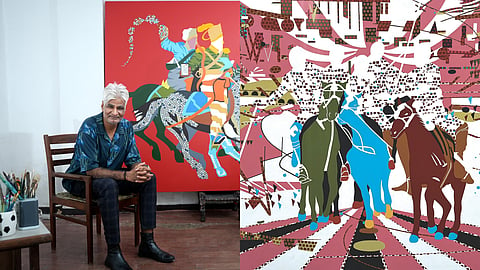
- HOMEGROWN WORLD
- #HGCREATORS
- #HGEXPLORE
- #HGVOICES
- #HGSHOP
- CAREERS
- ABOUT US
- CONTACT US

Mukesh Sharma is a New Delhi–based artist whose work unsettles boundaries between painting, printmaking, and installation. Trained at the Rajasthan School of Art, Jaipur (BFA, 1996) and the Faculty of Fine Arts, MS University, Baroda (MFA, 1998), Sharma has built a practice that is as conceptually layered as it is materially rich. His practice probes questions of modernisation, consumerism, cultural displacement, and environmental fragility — issues that resonate with both India’s contemporary reality and global anxieties.
Sharma’s installations are marked by a restless materiality. He transforms discarded computer keyboards, industrial paints, glue, metal sheets, wood, acrylic, gota patti embroidery, and gold foil into dreamlike, textured worlds. By weaving together the industrial and the ornamental, he produces landscapes and figures that seem at once familiar and otherworldly. These assemblages resist conventional hierarchies of beauty, suggesting instead that our throwaways — the material residue of consumer culture — can also hold meaning, memory, and critique.
At the heart of Sharma’s practice exists a tension between tradition and modernity. India’s rapid modernisation in the 21st century has created both aspiration and alienation, and Sharma responds by reimagining this duality through material experimentation. The glint of gold foil echoes the sumptuousness of Indian miniature painting, while its juxtaposition with metal sheets or laser-cut components recalls the cold precision of industrial production. In this interplay, Sharma stages a cultural dialogue: What does it mean to hold onto tradition when modernisation accelerates? How do societies negotiate authenticity in a world where technology dictates the pace of life?
Environmental concerns also appear prominently in his work. Sharma frequently uses discarded consumer electronics, focusing on their physical presence and symbolic significance in his work. In Sharma’s works, a discarded computer keyboard no longer functions as a tool for connectivity and productivity; instead, it becomes a symbol of obsolescence, a fossil of the Anthropocene. By transforming e-waste into sculptural forms, Sharma draws attention to the environmental costs of progress, encouraging viewers to consider the hidden afterlives of the objects that shape our everyday lives.
Equally central to Sharma’s multi-disciplinary practice is an interrogation of identity and socio-political conditioning. His surreal, layered compositions imagine spaces where individuals might exist outside the rigid frameworks of class, caste, and consumer categories. His art gestures toward freedom — from societal expectations, from the compulsions of conformity, and from the linear narratives of development. In this way, Sharma’s practice connects to postcolonial discourse: his works question what it means to inhabit a world where inherited traditions, imposed modernities, and global capital are perpetually in collision.
Exhibited across India and internationally — including in Melbourne, Mexico City, London, Paris, New York, Seoul, and Venice — Sharma’s works have been widely collected and critically noted. Institutions such as the Museum of Art & Photography (MAP), The National Gallery of Australia, and RMIT University feature his works in their permanent collections. His art has also been featured in leading publications, including The Wall Street Journal and Art India Magazine. Recently, Sharma collaborated with author Salman Rushdie on the cover design for the French edition of Rushdie’s landmark novel Shalimar the Clown.
By combining nostalgia with futurism, ornament with debris, and intimacy with scale, Mukesh Sharma reconfigures the fragments of a rapidly changing world. His practice interrogates whether beauty and authenticity can still be imagined in the ruins of consumer culture — and whether art can serve as a site of freedom in the face of systemic constraints.
Follow Mukesh Sharma here.
If you enjoyed reading this, here’s more from Homegrown:
'Mapusa Mogi': Help Fund Orijit Sen’s Tender Love Letter To The Markets of Mapusa
Jewellery As Homecoming: Anjali Gupta’s First Collection Is An Ode To Bihar & Her Family
Teeny Tiny India: 3 Artists Shrinking Streets, Snacks, & Stories Into Miniature Form
